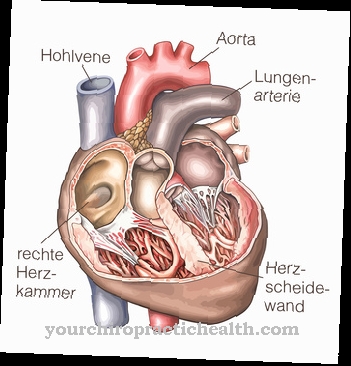The Countercurrent principle is a biological functional principle that is involved in the thermoregulation of many animals, in the breathing of fish such as sharks and in processes such as the human urine concentration. Most diuresis in humans takes place in the so-called Henle loop of the renal medulla and is characterized by systems with opposite flow directions. One related disease is hereditary and mutation-related Barrter's syndrome.
What is the countercurrent principle?

The biological countercurrent principle has different meanings. For the animal world, the functional principle plays a role primarily in thermoregulation. In the human body it is particularly relevant for the exchange of substances in kidney tissue. An opposite direction of flow in neighboring tissues ensures the efficiency of the exchange of substances.
The counter-current systems in human kidney tissue are used in particular to conserve substances and energy. The Henle loop within the nephron is a prime example in the human body of the functional principle of the counter-current flow in neighboring anatomical structures. The loop section of the renal tubule system located in the renal medulla is referred to as the Henle loop Urine serves.
The Henle loop and thus one of the most important countercurrent principles in humans takes place within the outer medullary zone. The principle is all-important for diuresis or urine formation and consists of three different components with opposite flow directions.
Sharks and other fish also use the countercurrent principle for breathing. They have a countercurrent exchanger in which oxygen-poor blood meets an oxygen-rich medium. During gas exchange there is contact between the blood and the oxygen-rich medium in order to maintain the oxygen partial pressure difference and to promote the further uptake of O2 from the medium.
Function & task
The countercurrent system of the human kidneys consists of three different components. The first of these is the thinly descending leg of the so-called Henle loop, the second element forms the thick ascending leg of the loop and the third element corresponds to the interstitium that is located between the first two components.
The thin, descending part of the Henle loop is permeable to water. The thick, ascending loop part is not. Within the ascending Henle loop portion, sodium ions migrate from the urine into the adjacent interstitium. This migration is done through active transportation. The water does not migrate into the interstitium, but remains in the urine. Unlike sodium, the impermeable parts of Henle's loop make it impossible for water to reach the interstitium. Because of this, the fluid becomes hypotonic while the interstitium becomes hypertonic.
Finally, water flows into the hypertonic interstitium from the descending thin part of the Henle loop. Because in this part of the loop the wall is permeable to water. In this way, the primary urine is concentrated: the concentration takes place within the descending part of the loop without additional expenditure of energy. Water is withdrawn from the primary urine when it is concentrated using the countercurrent principle.
The water recovery in the kidneys is possible thanks to the passive principle and is coupled to the reabsorption of sodium. This approach is extremely energy efficient.
The Henle loop has several floors, all of which are involved in the process at the same time. The simultaneous execution of the principle described in all levels of the Henle loop results in a fractional concentration of the urine. The concentration of electrolytes is highest in the apical part of the Henle loop, because in this part water was withdrawn from the primary urine over the entire length of the thinly descending thigh. The counter-current principle has contributed to the energy-efficient concentration of Hans through the opposite direction of flow of the neighboring tissues in the Henle loop of the kidneys.
You can find your medication here
➔ Medicines for bladder and urinary tract healthIllnesses & ailments
If the Henle loop of the kidneys is affected by diseases, disturbances of the countercurrent principle and thus of the urine concentration sometimes occur. Bartter syndrome is a relatively rare inherited disease of Henle's loop. More precisely, this disease affects the thick ascending branch of the loop. The cause of the disease is a defect in the Na + / K + / 2Cl− cotransporter, which is said to be furosemide-sensitive. Other variants of the disease are associated with a defect in the apical K + canal or go back to a defect in the basolateral Cl− canal. These channels cooperate with the Na + / K + / 2Cl - fecal transport during NaC1 reabsorption in the dilution segment and, in a healthy kidney, make a significant contribution to the functioning of the countercurrent principle in the ascending branch of the loop.
Due to the disturbed cooperation between the cotransporter and the channels, not enough sodium ions can be reabsorbed. Due to the reduced reabsorption, the patient's blood pressure drops. Because of the alarmingly low drop in blood pressure, the pressoreceptors in the wall of the aorta initiate a catecholamine release.
In addition, the drop in blood pressure also leads to reduced blood flow to the vasa afferentia. This reduced blood flow stimulates the release of renin. Hyperreninemic hyperaldosteronism is the result. In type IV disease, there is a defect in the bartin that corresponds to the essential β subunit in the ClC-K channel. This subunit is not only involved in the basolateral Henle loop membrane, but also in the basolateral inner ear membrane. For this reason, this sub-form of the disease is not only characterized by a disturbed countercurrent principle, but also by deafness.
All other diseases of the renal medulla zone can also disrupt the countercurrent principle, for example kidney cancer or necrosis of the kidney tissue located there. In addition, disturbances in urine concentration and its functional principle can be caused by numerous mutations. A total of five causal mutations have been documented for Barrter's syndrome alone.

















.jpg)







.jpg)


